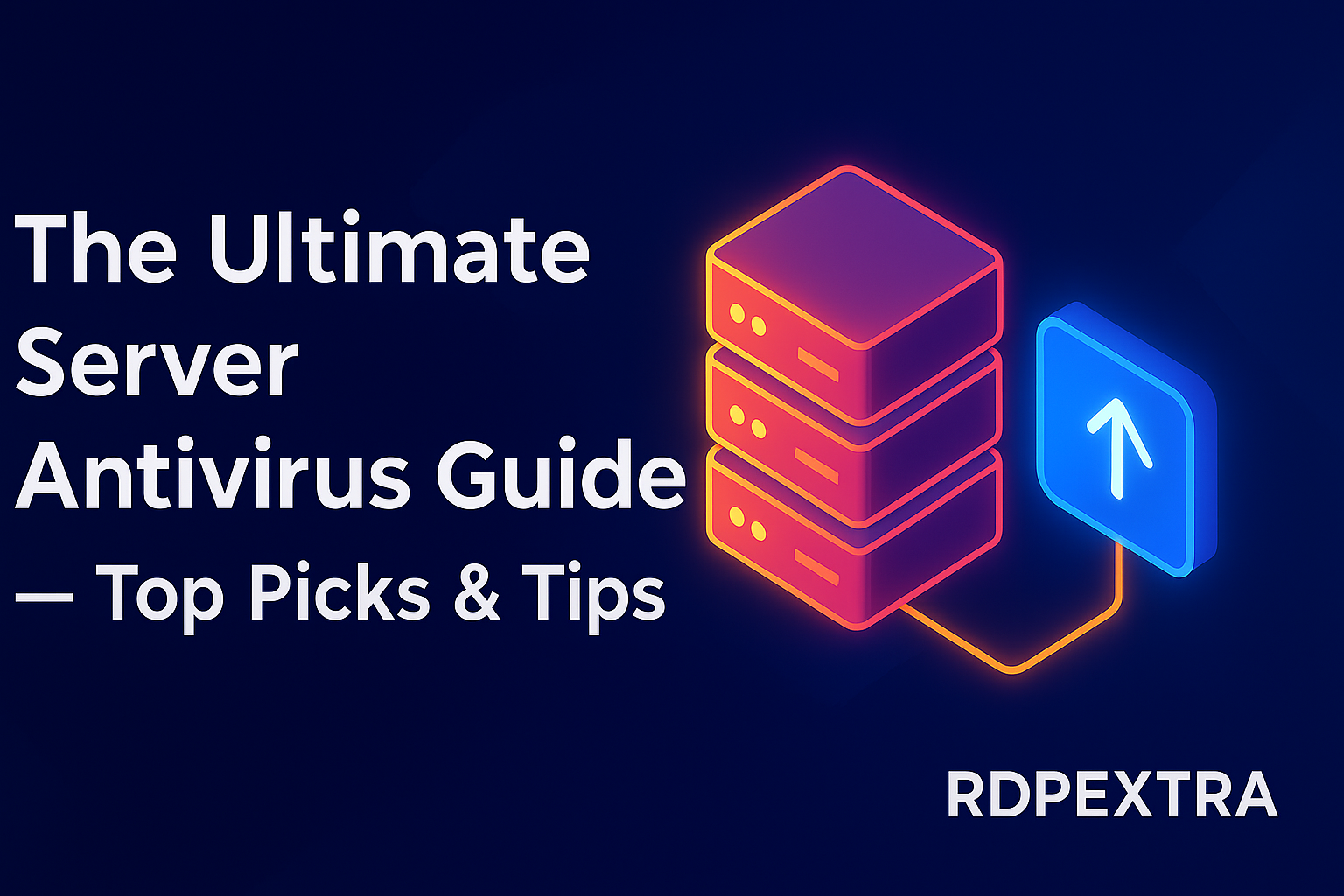
The Ultimate Server Antivirus Guide — Top Picks & Tips
Servers are different from laptops. They host your databases, authentication services, file shares, and customer workloads — the things your business stops doing if a server goes down. That’s why server antivirus software needs to be lean, accurate, and cloud-aware. In this guide, you’ll learn what to look for in server antivirus, how Linux server antivirus differs from antivirus for Windows Server, which tools are worth considering, and the deployment rules that actually stop outages (not false alarms).
Server threat landscape — why servers are special
top server antivirus are high-value targets: they hold sensitive data and run services that attackers monetize (ransomware, data theft, cryptomining). Attack vectors often come from:
- A vulnerable service or exposed management port.
- Compromised credentials or salted backups.
- Fileless attacks and privilege escalation that weaponize admin tools (PowerShell, systemd scripts).
Because servers are performance-sensitive and often host critical services, server antivirus software must balance protection with low overhead and clear, auditable actions.
What to look for in server antivirus software
When evaluating server antiviruses, use this checklist. Think of it as your “must-have” vs. “nice-to-have” decision matrix.
Core features (must-haves)
- Real-time scanning with low CPU/disk overhead.
- Behavioral/heuristic detection (not just signatures) to catch new threats.
- Rollback & ransomware protection (file recovery after blocked encryption).
- Centralized management & logging for group policy, alerts, and compliance evidence.
- Virtual- and cloud-friendly agents (cloud/VM aware, minimal IO).
- Support for both Linux & Windows server OSes (if you run both).
Linux server antivirus specifics
- Daemon-friendly agents that run without disrupting systemd services.
- On-demand & on-access scanning for shared file systems (NFS, Samba).
- Package-management awareness (avoid scanning package installs that will explode updates).
- Open-source options (ClamAV) are useful as a safety net but often need support layers for full protection.
Antivirus for Windows Server specifics
- Compatibility with Server Core and GUI installs.
- Integration with Active Directory and Group Policy for mass deployment.
- File server optimization to avoid scanning every file read on high-IO DB or file shares.
Cloud & virtualized workload needs
- Agent consolidation / single console across cloud providers (AWS, Azure, GCP).
- Cloud-native protections such as image scanning and workload microsegmentation.
- Low IO footprint to avoid cloud egress or storage cost spikes.
Antivirus vs EDR vs EPP — understanding the stack
Antivirus is still useful — signature + heuristic scanning stops many malware families. EDR (Endpoint Detection & Response) provides continuous monitoring, behavioral analysis, and investigation tools to detect sophisticated or novel attacks. EPP (Endpoint Protection Platform) bundles antivirus, EDR, firewall, and sometimes vulnerability management.
If you manage a few servers for internal tools, a robust server antivirus may be enough. If you host customer data, provide SaaS, or operate in regulated industries, pair antivirus with EDR/EPP for full visibility and response. The trend in 2024–25 is clear: organizations combine anti-malware with EDR for faster detection and automated response. Palo Alto NetworksCyble
Top server antivirus recommendations (practical, purpose-driven picks)
Below are real-world recommendations mapped to common needs. These are not exhaustive, but represent well-regarded server antiviruses and workload protection suites to consider.
Top picks at a glance (good starting shortlist):
- Microsoft Defender for Servers — great for Windows-first shops and multi-cloud integration.
- Bitdefender GravityZone (Cloud/Server) — strong cross-platform protection for hybrid data centers.
- Sophos Intercept X for Server — deep learning, exploit prevention and ransomware rollback for servers.
- Trend Micro Deep Security — designed for data centers, VMs and cloud workloads (intrusion prevention + malware).
- ESET File / Server Security — lightweight, well-tuned for Windows servers and file servers.
Which to pick (quick guidance):
- Best for Windows Server + Azure/AWS integration: Microsoft Defender for Servers — integrates into Defender for Cloud and Defender for Endpoint, easy onboarding for Windows Server fleets.
- Best cross-platform (Linux + Windows) enterprise fit: Bitdefender GravityZone — single console, cloud workload focus.
- Best for ransomware defense & exploit prevention: Sophos Intercept X for Server — includes rollback and anti-exploit tech.
- Best for virtualized/data center environments: Trend Micro Deep Security — modules for IPS, anti-malware, and integrity monitoring.
- Best open-source / budget option: ClamAV (on Linux) for scanning and detection; pair with monitoring/EDR for better coverage. (ClamAV is a solid free scanner, but not a full EDR.)
Note: many organizations run a server antivirus + EDR combo (antivirus as prevention + EDR for detection and automated response). The right mix depends on risk profile, compliance needs, and budget.
(Caveat: each environment is unique — test any product in a non-production environment before full deployment.)
Deployment best practices — make protection practical
A deployed antivirus is only as good as the policies around it. Follow these practical rules:
- Start with an asset inventory. Know what servers exist, OS versions, and critical services. Tag them (DB, file, web, AD).
- Stagger rollouts. Pilot on a non-critical server for 2–4 weeks. Monitor performance and false positives.
- Use centralized management. Enforce policies, push updates, and gather logs from one console.
- Tune exclusions correctly: exclude database DB file paths, backup repositories, and hypervisor snapshots — but keep exclusions minimal and well-documented.
- Schedule deep scans off-peak. Use low-priority or incremental scanning for high-IO servers (databases, file servers).
- Automate updates & signature pushes. Ensure agents auto-update and report health.
- Integrate with SIEM and backups. Forward alerts to your SIEM and make sure backups are immutable (ransomware-safe).
- Test incident playbooks. Run tabletop exercises: what happens if a server is flagged? Who isolates it? Who restores?
Common pitfalls and how to avoid them
- Performance hits on DB servers: fix by excluding DB data directories and using agent modes designed for file servers.
- Too many false positives: start with detection-only mode during pilot, refine whitelist/allowed lists, then enable automatic remediation.
- Outdated agent versions: enforce patch policies and monitor agent uptimes.
- Assuming “antivirus = security”: antivirus prevents many threats, but EDR and network controls are needed for fast detection and remediation.
- Not monitoring alerts: set actionable alert thresholds and own the incident response process.
Cost, licensing & compliance — what to budget for
- Per-server licensing is common; expect different SKUs for servers vs workstations. Some vendors charge extra for advanced EDR/XDR features.
- Managed detection & response (MDR) increases cost but lowers operational overhead — good for lean security teams.
- Compliance: ensure your solution provides logs and report exports needed for audits (PCI, HIPAA, SOC2).
Quick checklist (deployable in 10 minutes)
- Inventory servers & tag by role.
- Pick a candidate product and run a 2-week pilot.
- Configure central console + automated updates.
- Define 3 critical exclusions (DB, backups, hypervisor directories).
- Test file recovery & incident isolation playbook.
Conclusion — protect what keeps the lights on
Servers keep your business running, and leaving them unprotected is like locking your doors but leaving the windows wide open. The right server antivirus software balances strong security with performance, whether you’re on Linux, Windows Server, or in the cloud. Pairing antivirus with smart policies and EDR where needed ensures resilience against evolving threats. Want a simple way to get started? Download our free Server Antivirus Deployment Checklist and secure your servers with confidence.
Yes — while Linux is less targeted than Windows, it hosts many server workloads (web, mail, file servers) and can be a conduit for malware or for distributing infected files. Run a linux server antivirus for shared-file scanning and to catch threats that cross to Windows clients.
Antivirus focuses on prevention (signatures + heuristics). EDR provides continuous monitoring, behavioral detection, and response capabilities for advanced or novel threats. Combine them for best results.

Leave a Reply